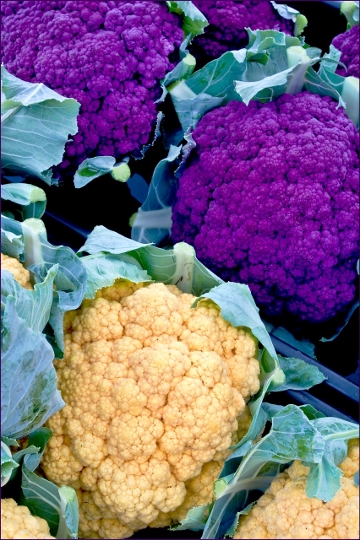Photography by E.W. Faircloth
Bridgeville DE
Email: wayne@faircloth.org
Bridgeville DE
The original post for picture(s) done on 2012-06-09 by E.W. Faircloth can be found at
https://faircloth.org/blog1/?p=6578

Bridgeville DE
Email: wayne@faircloth.org
Bridgeville DE
The original post for picture(s) done on 2012-06-09 by E.W. Faircloth can be found at
https://faircloth.org/blog1/?p=6578

Tags: I see it this way!
My buddy Jon Falk took the above picture of cauliflower at a farm market after setting out to find something worthy of his camera. The farmer named them "grape" and "cheese" cauliflower. On the Internet, I found something about "purple cauliflower". From an website called Specialty Produce : Seasons/Availability Purple cauliflower is available year round with a peak season during the winter months. Current Facts Purple cauliflower is a cool-season biennial cruciferous vegetable, botanical name Brassica oleracea var. botrytis, belonging to the plant order Capparales. Purple cauliflower's color is due to the presence of the antioxidant anthocyanin, which can also be found in red cabbage and red wine. Purple cauliflower also goes by the variety names Sicilian Violet, Violet Queen and Grafitti cauliflower. Description/Taste Displaying vibrant violet hues, Purple cauliflower may be different in color than its white counterpart, however, on the outside, that is the only difference. The entire plant (floret, stalk and leaves) is edible. The stems and trunk are firm and tender and the florets have a dense yet soft and crumbly texture. It's flavor is milder, sweeter, nuttier and free of the bitterness sometimes found in White cauliflower. Nutritional Value Cauliflower is rich in vitamin C with a half cup of florets providing nearly half of ones daily requirement for vitamin C. It also provides a fair amount of fiber, vitamin A, folate, calcium and potassium as well as selenium, which works with Vitamin C to boost the immune system. Cruciferous vegetables such as cauliflower are known for their high levels of cancer-fighting phytochemicals know as glucosinolates. Applications Purple cauliflower can be chopped in to individual florets and eaten raw, or roasted and paired with additional flavors such as garlic or balsamic vinegar. The vibrant color is a nice visual counterpoint for green hued vegetables like green beans, peas or broccoli. Blend steamed cauliflower with beans for a unique spread for toast or crackers. Use within a few days of purchase for best color and texture. Ethnic/Cultural Info Cauliflower was brought to England by Flemish weavers in the mid-1600s and later became the rage of the French court, where Louis XV's mistress, Comtesse du Barry had a consomme of veal, oxtails and cauliflower named for her. In the modern era, cauliflower fell into a period of obscurity, languishing upon crudite trays and within obvious soups and gratins. Its renaissance can be attributed to the discovery of colorful varieties, such as the purple Graffiti and purple Cape.